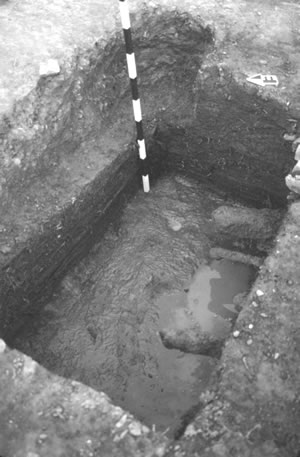Why Archaeology?
![Both of these early 20th century bottles were found at Site 44PY181. The dairy bottle (left) is from Clover Hill Farm in Danville. The bottle on the right would have contained one the soft drinks manufactured by the Virginia Fruit Juice Co. of Norfolk. Numerous other identifiable bottles from the sites Front Street tell us about the types of consumer goods available to mill families and where they were manufactured. (left - 5-3/8in tall, from Feature 14, L.I [privy]; right - 7-3/8in tall, from Feature 18 [builder's trench])](/sites/wmcar/_images/projects/danville/2bottlesbig.jpg) At first, it might seem surprising that the sites on Front Street would be of interest to archaeologists. Both dated mainly to the first half of the twentieth century. If we think about their information potential, though, we can recognize their appeal. Both sites contained archaeological “features” (manmade disturbances in the soil) such as trash-filled privies, “slop” holes for human waste, and structural trenches. Household trash and other artifacts within these “time capsules” of soil can answer questions about which written records are silent or confusing. Fragments of a fruit juice bottle from West Virginia or the depth and placement of privies, for example, reveal some of the countless details of daily living. In turn, these details help us answer more general questions about the lives of millworkers in Danville and other Southern textile towns.
At first, it might seem surprising that the sites on Front Street would be of interest to archaeologists. Both dated mainly to the first half of the twentieth century. If we think about their information potential, though, we can recognize their appeal. Both sites contained archaeological “features” (manmade disturbances in the soil) such as trash-filled privies, “slop” holes for human waste, and structural trenches. Household trash and other artifacts within these “time capsules” of soil can answer questions about which written records are silent or confusing. Fragments of a fruit juice bottle from West Virginia or the depth and placement of privies, for example, reveal some of the countless details of daily living. In turn, these details help us answer more general questions about the lives of millworkers in Danville and other Southern textile towns.
Even though the sites held a treasure of information, our dig could not attempt to answer every conceivable question about the people who lived there. Instead, we carefully prepared a “research design” long before digging began. A research design narrows the goals to a list of managable topics best suited to the particular site. It also outlines the best ways to organize the work in the field (and later the laboratory) to answer those questions.
The excavations focused on archaeological deposits from the turn of the twentieth century through the Depression—the period of most intensive activity on the sites and a time of immense change in goods and services and health reform in America. Our research would try to find out how these transformations played out in the lives of millworkers at the Danville sites and more generally in other Southern textile towns. To address this general research goal, we would focus on two aspects of the site: yard layout and “material culture.”

Yard Layout
The presence and position of outhouses and trash disposal areas, for example, could reveal much about the transition to modern conveniences. In other mill towns of this period, scholars also had noted the existence of “urban farmsteads.” Only recently removed from their rural background, millworkers yards often included gardens, animal pens, or work sheds to help supplement their lifestyle. Archaeology not only reveals quite specific information about individual features (often only vaguely discussed in documents or oral accounts). Through dating the features, archaeology also shows how the yards, and by extension the lifestyles of the millworker tenants, evolved through time.
Material Culture
By this term, we mean the objects used by the people who occupied the site. Besides the bits and pieces from archaeological sites most commonly defined as “artifacts”—such as broken tableware, bottles, or buttons—we also can include animal bone and seeds that tell us about diet, or parasites indicative of disease.
Through careful analysis of this collected material, we can begin to answer a host of specific questions about the lives of millworkers. Does the material culture at these sites reflect the mass production and marketing that surged at the beginning of the twentieth century? What was the state of health as reflected in foodways and sanitation practices? Perhaps most intriguing, questions about material culture could focus on the degree of independence millworkers exercised at home—“off the clock” but still in the shadow of the mill. According to one scholar, mill owners tried to shape their workers’ behavior, requiring them to “avoid alcohol, attend church, complete their basic schooling, and learn responsibility from intelligent men.” At the same time consumerism was encouraged to increase workers’ dependence on their wages and loyalty to the company (Zingraff 1991:202). Archaeology can add substance to these sweeping notions (or challenge them) by looking at material evidence of millworkers’ lives. Even though these sites in Danville are not from a distant past like the Egypt of the pharaohs, they hold answers to questions that are still elusive without archaeology.
 Skip to main content
Skip to main content
